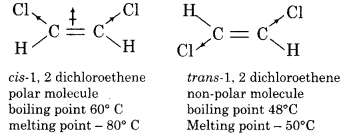Rajasthan Board RBSE Class 12 Chemistry Chapter 16 Stereo Chemistry
RBSE Class 12 Chemistry Chapter 16 Text Book Questions
RBSE Class 12 Chemistry Chapter 16 Multiple Choice Questions
Question 1.
Which of the following is not involved in a branch of stereochemistry?
(a) Geometrical isomerism
(b) Conformational isomerism
(c) Functional group isomerism
(d) Optical isomerism
Question 2.
Which of the following compounds do not show geometrical isomerism?
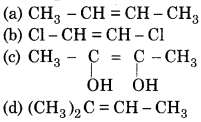
Question 3.
Which of the following statements is not true about optical isomerism?
(a) Axis of symmetry is present in the molecule
(b) Plane of symmetry is present in the molecule
(c) Centre of symmetry is present in the molecule
(d) None of the above
Question 4.
Meso tartaric acid does not show optical activity because
(a) It has two chiral centres
(b) It shows external compensation
(c) It has a plane of symmetry
(d) It has an erythro form
Question 5.
Which of the following do not show optical isomerism?
(a) Ethyl Alcohol
(b) 2 – Butanol
(c) 2 – Chloropropane
(d) Lactic acid
Question 6.
Which of the following statement is not true for writing Fischer Projection formula?
(a) Two perpendicular lines intersecting each other are drawn
(b) First number carbon is placed on the left side.
(c) Both the groups of horizontal surface are directed above.
(d) Plane of the molecule can be rotated by 180°.
Question 7.
Which molecule is considered as standard in respect to relative configuration?
(a) Lactic acid
(b) Tartaric acid
(c) Glyceraldehyde
(d) Sodium potassium titrate
Question 8.
Which of the following method is not employed in the resolution of the racemic mixture?
(a) Biochemical method
(b) Mechanical method
(c) Effective distillation
(d) Column chromatography
Question 9.
Which of the following statements is not true about conformational isomerism?
(a) These can be represented by Newman and Sawhorse projections.
(b) The number of conformational isomers is infinite.
(c) The eclipsed form is most stable.
(d) Conformational isomerism is also found in the cyclic compound.
Question 10.
Which of the following statements is not true about diastereomers?
(a) They do not show optical activity.
(b) These isomers show the difference in physical properties.
(c) They show internal compensation.
(d) They scatter plane of polarised light.
Answers:
1. (c)
2. (d)
3. (d)
4. (c)
5. (a)
6. (b)
7. (c)
8. (c)
9. (c)
10. (d)
RBSE Class 12 Chemistry Chapter 16 Very Short Answer Type Questions
Question 1.
Define isomerism.
Answer:
Two or more than two compounds having the same molecular formula but differing in their physical and chemical properties are called isomers (Greek: iso = equal, meros = parts) and this phenomenon is known as isomerism.
Question 2.
What do you understand by stereochemistry?
Answer:
The branch of chemistry which deals with three-dimensional molecules and their effect on physical and chemical properties is known as stereochemistry.
Question 3.
What is an optical activity?
Answer:
Compounds which rotate the plane of polarised light are called optically active compounds and the property is known as an optical activity.
Question 4.
What are the essential conditions for optical isomerism?
Answer:
The compound must be asymmetric or having at least one chiral centre for optical isomerism.
Question 5.
What do you understand by symmetry?
Answer:
Elements of symmetry offer a simple device to decide whether a molecule (or object) is chiral or not i.e. whether it is superimposable on its mirror image or not.
Question 6.
Meso form is optically inactive, Why?
Answer:
Meso form is optically inactive because the molecules in meso form have a plane of symmetry due to which the optical rotations of upper and lower parts are equal and in the opposite direction which balanced internally and compound becomes optically inactive. This property is called internal compensation.
Question 7.
What is racemisation?
Answer:
The optical rotation of equimolar mixture of two enantiomers (d and l) will be zero because rotation produces by one isomer will cancel the rotation produced by other isomers. So, such types of the mixture are called racemic mixture and the phenomenon of converting optically active isomers (d (or) l) into the optically inactive mixture is called racemization.
RBSE Class 12 Chemistry Chapter 16 Short Answer Type Questions
Question 1.
Define optical activity. Explain with the example which type of molecules show optical activity.
Answer:
Optical Activity:
Compounds which rotate the plane of polarized light are called optically active compounds and this property is known as optical


and is optically active compounds. They have one chiral centre each.
Question 2.
1 – Butanol does not show optical isomerism whereas 2 – Butanol shows, Why?
Answer:
1 – Butanol does not show optical isomerism whereas 2 – butanol shows because 1 – butanol has no asymmetric carbon and 2 – butanol has one asymmetric carbon.

Question 3.
What are the necessary conditions for optical activity? Give an example of optically active molecules.
Answer:
Necessary conditions for optical activity:
- The compound must contain an asymmetrical carbon atom.
- The molecule must contain a chiral axis.
- The molecule must possess a chiral plane.
- The molecule does not possess any elements of symmetry.
Examples of optically active compounds:
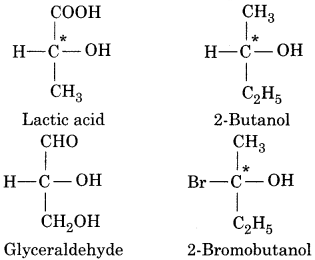
Question 4.
Interpret two optical isomers of Lactic acid?
Answer:
Lactic acid has only one asymmetric carbon atom. d – Lactic acid rotates the plane of polarised light to right (clockwise) and l – lactic acid rotates to left (anticlockwise).
Two optical isomers of lactic acid are as follows:
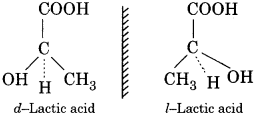
Question 5.
Describe racemisation giving suitable examples.
Answer:
Racemisation:
When equal amounts of dextrorotatory and laevorotatory isomers are mixed then the resulting mixture becomes optically inactive because optical activities of each isomer cancel each other. Such a mixture is called a racemic mixture and this phenomenon is called racemization. Racemisation can be done by the following methods:
1. By simple heating:
It is also called thermal racemisation. The racemic mixture of tartaric acid, lactic acid etc. can be obtained by this method.
2. Auto racemisation:
Racemisation of some compounds takes place at room temperature. It is called auto racemisation. For example, auto racemisation of dimethyl succinate takes place at room temperature.
3. Chemical racemisation:
When a racemic mixture is obtained by mixing a chemical then it is called chemical racemisation. For example, 2-butyl phenyl ketone gives a racemic mixture on adding an acid. We can represent the thermal racemisation of lactic acid as follows:
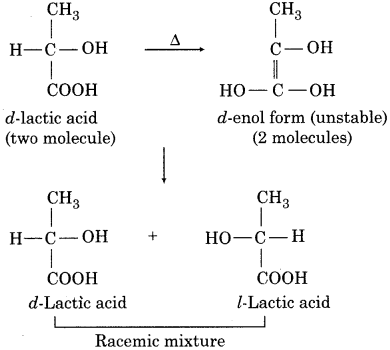
Question 6.
Explain erythro and three isomers giving suitable examples.
Answer:
When two similar groups at non-identical chiral carbons are on the same side of the vertical line of the Fischer projection, the isomer is called erythro isomer, if the groups are on opposite sides, the isomers are called three isomers.
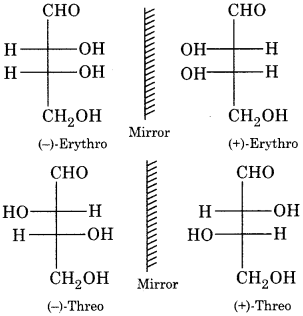
Question 7.
What do you understand by absolute configuration?
Answer:
In 1950, when X-ray crystallographic techniques were developed then Bijvoet found that the form of glyceraldehyde which is given D-configuration is actually D – form. In other words, the configuration which is considered as standard for other compounds is actually its absolute configuration.
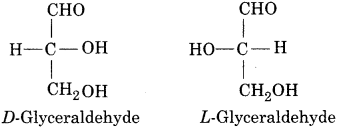
Question 8.
What are the differences between conformation and configuration?
Answer:
Differences between conformation and configuration:
| Confirmation | Configuration |
| Conformations have low energy barrier, which varies from 4.2 to 46 kJ per mole. | The difference in energy between the two configurations is more than 84 kJ/ mole. |
| Conformers are non-ionisable. | Configurations are ionisable. |
| Conformers are easily interconvertible. | Configurations are not easily interconvertible. |
| A molecule could have an infinite number of conformations. | A molecule can have only one configuration. |
Question 9.
What do you understand by geometrical isomerism? Write essential conditions for geometrical – isomerism.
Answer:
Geometrical isomerism:
The isomerism which arises due to frozen rotation about to bond in a molecule is known as geometrical or cis-trans isomerism. Conditions for geometrical isomerism: A compound will show geometrical isomerism if it fulfils the following two conditions:
1. There should be restricted (frozen) rotation about a bond in the molecule.
2. Both substituents on each carbon about which rotation is frozen (restricted) should be different.
Example:

Question 10.
Explain the stereochemistry of oximes.
Answer:
The reaction of aldehydes or ketones with hydroxylamines gives aldoximes and ketoximes as:

It is clear that in CN both C and N are in sp2hybridisation. Due to the presence of a double bond, free rotation is not possible. If OH group on N atoms is present on hydrogen attached to carbon or to a small group, then this is called ‘syn’ and if opposite then it is called ‘anti’.
For example:
Acetaldoxime (CH3CH = NOH)
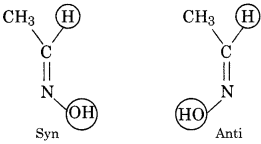
Benzaldoxime
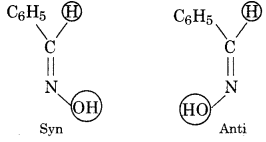
Similarly, Acetophenone oxime
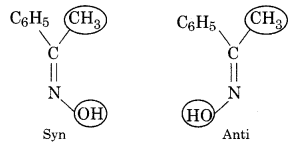
Question 11.
Draw the Newman projection formula for different conformations of ethane.
Answer:
Conformations:
The different spatial arrangements of atoms in a molecule which are readily interconvertible by rotation about single bonds are called conformations. Conformations represent conformers which are readily interconvertible and thus nonseparable.
Newman projection formula for different conformations of ethane:
When an ethane molecule rotates about its carbon – Carbon single bond, two extreme conformations can result in the staggered conformation and the eclipsed conformation.
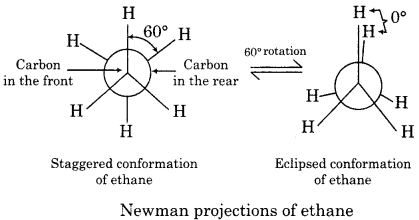
Question 12.
Describe the salt formation method for the separation of enantiomers.
Answer:
The process of separation of a racemic mixture into the enantiomers.
Chemical method (salt formation method):
Consider a racemic mixture of enantiomeric organic acid (I) – HA. It can be separated into pure enantiomeric acid by reaction with an optically active base, say a laevorotatory base (-) – B. The mixture of enantiomeric acids on reaction with an optically active base result in the formation of two diastereomeric salts as shown in the figure. These diastereomeric salts have, of course, different physical properties, including solubility in a given solvent. They can, therefore, be separated, by a simple technique i.e., fractional crystallization.
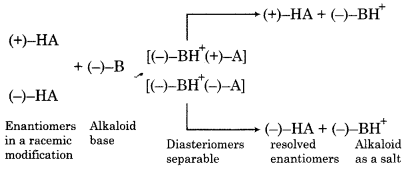
RBSE Class 12 Chemistry Chapter 16 Long Answer Type Questions
Question 1.
Discuss optical isomerism in tartaric acid.
Answer:
Tartaric acid can be taken as an example.

It has two asymmetric carbon atoms so using the 2n formula there should be a maximum of 22 = 4 stereoisomers. These can be represented as:
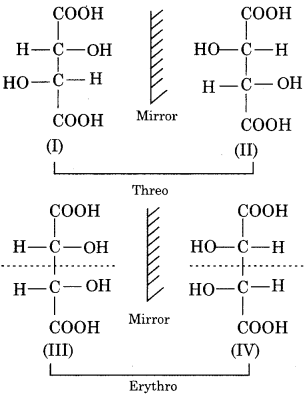
I and II i.e., threo forms are mirror images of each other and are enantiomers. But in erythro form, the plane of symmetry is present. Thus, it does not show optical isomerism. Therefore, tartaric acid exists only in three isomeric forms of which one is meso (optically inactive) and the other two are optically active, i. e., d (or) (+) and l or (-).
Question 2.
Explain diastereoisomers with example.
Answer:
The optical isomers which do not mirror images of each other are called diastereoisomers and this phenomenon is called diastereoisomerism.
Their characteristics are given below:
1. These isomers can not superimposable to each other.
2. Diastereoisomerism is found only, in those compounds in which at least two chiral carbon centres are present.
3. The physical properties like melting point, boiling point, solubility, spectre rotation etc of diastereoisomers of a compound are different. So, these can be separated by fractional distillation, fractional crystallisation and chromatographic methods easily.
Example:
Cinnamic acid dibromide
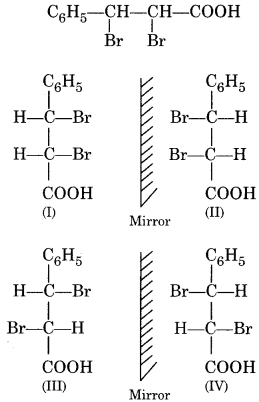
Here, I & II and III & IV one enantiomers as there are mirror images of each other. However, I & II, I & IV, II & III and II & IV are diastereomers.
Question 3.
What is stereoisomerism? Discuss stereoisomerism in tartaric acid and write the structural formula of all its isomers. Explain when tartaric acid is synthesised then it is optically inactive.
Answer:
Compounds having the same constitutions but the different spatial arrangement of their atoms are known as stereoisomers and this phenomenon is called stereoisomerism.
Tartaric acid can be taken as an example:

It has two asymmetric carbon atoms so using the 2n formula there should be a maximum of 22 = 4 stereoisomers. These can be represented as:
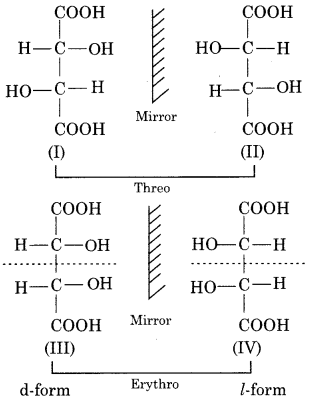
I and II i.e. the forms are mirror images of each other and are called enantiomers but in erythro form i.e., meso form, the plane of symmetry is present thus it does not show optical activity. Therefore, tartaric acid exists only in three isomeric forms of which one is meso (optically inactive) and the other two are optical active i.e., d (or) (+) and l or (-).
Question 4.
What do you understand by optical isomerism? Discuss optical isomerism in compounds having two asymmetric carbon atoms.
Answer:
Optical isomerism:
Compounds which have the same molecular formula but differ in optical activity are known as optical isomers and the isomerism exhibited by them is called optical isomerism.
Optical isomerism in compounds having two asymmetric carbon atoms:
(i) – 2, 3 dichlorobutane acids (asymmetric molecule):
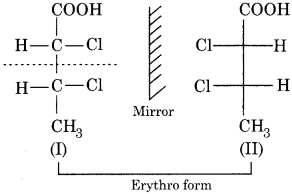
The structure I and II and structure III and IV are mirror images. These are known as enantiomers.
(ii) 2, 3 dihydroxy butanoic acids:
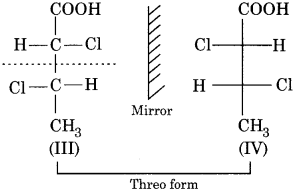
Structures I and II and structures III and IV are mirror images. These are known as enantiomers.
Question 5.
Explain stereoisomerism in tartaric acid. How many optical isomers are possible for tartaric acid? What are the differences between meso tartaric acid and racemic mixture?
Answer:
Compounds having the same constitutions but the different spatial arrangement of their atoms are known as stereoisomers and this phenomenon is called stereoisomerism.
Tartaric acid can be taken as an example:

It has two asymmetric carbon atoms so using the 2n formula there should be a maximum of 22 = 4 stereoisomers. These can be represented as:

I and II i.e. the forms are mirror images of each other and are called enantiomers but in erythro form i.e., meso form, the plane of symmetry is present thus it does not show optical activity. Therefore, tartaric acid exists only in three isomeric forms of which one is meso (optically inactive) and the other two are optical active i.e., d (or) (+) and l or (-).
Differences between meso and racemic tartaric acid:
| Meso Tartaric Acid | Racemic Mixture |
| The angle of optical rotation of meso tartaric acid is 0°. | Its angle of optical rotation is also 0°. |
| It is melting point is 140°C. | It is melting point is 260°. |
| It can not be separated into two forms. | It can be separated into two forms. |
| It is optically inactive due to internal compensation. | It is optically inactive due I to external compensation. |
Question 6.
The physical properties of geometrical isomers are different whereas physical properties of optical isomers are the same. Explain with reason.
Answer:
Although geometrical isomers have completely different physical and chemical properties (for example cis and trans 2 – butene, have different boiling points and densities), optical isomers (also called enantiomers) differ in only one characteristic – their interaction with plane polarized light.
Physical properties of geometrical isomers depend on
1. The polarity of the molecules.
2. The shape or symmetry of molecules.
The polarity strongly influences the relative boiling points as it determines the strength of the intermolecular forces.
For example, cis – 1, 2 dichloroethene has a net dipole moment and dipole-dipole attractions between its molecules in addition to the van der Waal’s forces, whereas trans 1, 2 dichloroethene which is non-polar has only van der Waal’s forces. The boiling point of the cis-isomers is therefore higher. Melting point is generally, more influenced by the symmetry of the molecules as this affects the packing in the solid state. The trans – isomers are able to pack more closely due to their greater symmetry, so the intermolecular forces are more effective than in the ch – isomer. The melting point of the trans-isomer is therefore higher.
